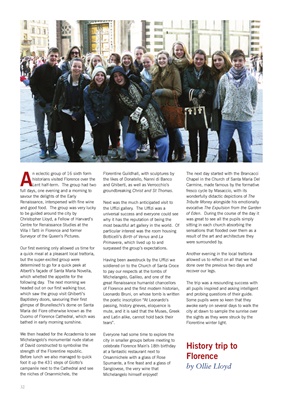
A
n eclectic group of 16 sixth form
historians visited Florence over the
Lent half-term. The group had two
full days, one evening and a morning to
savour the delights of the Early
Renaissance, interspersed with fine wine
and good food. The group was very lucky
to be guided around the city by
Christopher Lloyd, a Fellow of Harvard's
Centre for Renaissance Studies at the
Villa I Tatti in Florence and former
Surveyor of the Queen's Pictures.
Our first evening only allowed us time for
a quick meal at a pleasant local trattoria,
but the super-excited group were
determined to go for a quick peek at
Alberti's façade of Santa Maria Novella,
which whetted the appetite for the
following day. The next morning we
headed out on our first walking tour,
which saw the group visit Ghiberti's
Baptistery doors, savouring their first
glimpse of Brunelleschi's dome on Santa
Maria del Fiore otherwise known as the
Duomo of Florence Cathedral, which was
bathed in early morning sunshine.
We then headed for the Accademia to see
Michelangelo's monumental nude statue
of David constructed to symbolise the
strength of the Florentine republic.
Before lunch we also managed to quick
foot it up the 431 steps of Giotto's
campanile next to the Cathedral and see
the niches of Orsanmichele, the
Florentine Guildhall, with sculptures by
the likes of Donatello, Nanni di Banco
and Ghiberti, as well as Verrocchio's
groundbreaking Christ and St Thomas.
Next was the much anticipated visit to
the Uffizi gallery. The Uffizi was a
universal success and everyone could see
why it has the reputation of being the
most beautiful art gallery in the world. Of
particular interest was the room housing
Botticelli's Birth of Venus and La
Primavera, which lived up to and
surpassed the group's expectations.
Having been awestruck by the Uffizi we
soldiered on to the Church of Santa Croce
to pay our respects at the tombs of
Michelangelo, Galileo, and one of the
great Renaissance humanist chancellors
of Florence and the first modern historian,
Leonardo Bruni, on whose tomb is written
the poetic inscription "At Leonardo's
passing, history grieves, eloquence is
mute, and it is said that the Muses, Greek
and Latin alike, cannot hold back their
tears".
Everyone had some time to explore the
city in smaller groups before meeting to
celebrate Florence Main's 18th birthday
at a fantastic restaurant next to
Orsanmichele with a glass of Rose
Spumante, a fine feast and a glass of
Sangiovese, the very wine that
Michelangelo himself enjoyed!
The next day started with the Brancacci
Chapel in the Church of Santa Maria Del
Carmine, made famous by the formative
fresco cycle by Masaccio, with its
wonderfully didactic depictions of The
Tribute Money alongside his emotionally
evocative The Expulsion from the Garden
of Eden. During the course of the day it
was great to see all the pupils simply
sitting in each church absorbing the
sensations that flooded over them as a
result of the art and architecture they
were surrounded by.
Another evening in the local trattoria
allowed us to reflect on all that we had
done over the previous two days and
recover our legs.
The trip was a resounding success with
all pupils inspired and asking intelligent
and probing questions of their guide.
Some pupils were so keen that they
awoke early on several days to walk the
city at dawn to sample the sunrise over
the sights as they were struck by the
Florentine winter light.
History trip to
Florence
by Ollie Lloyd
32